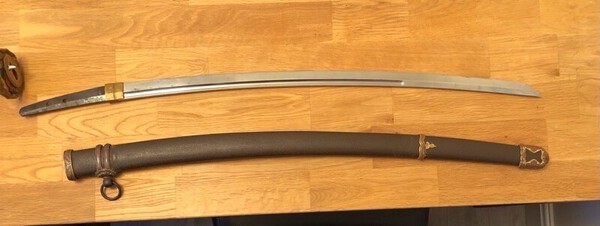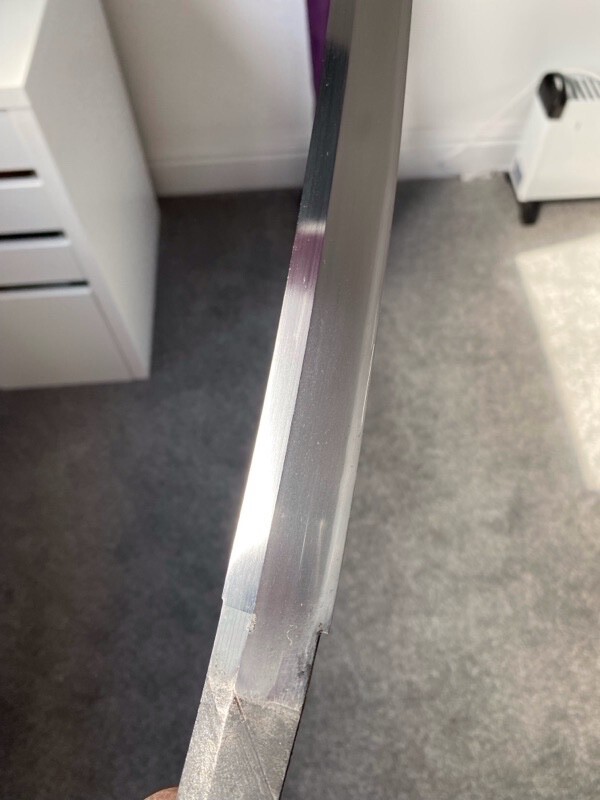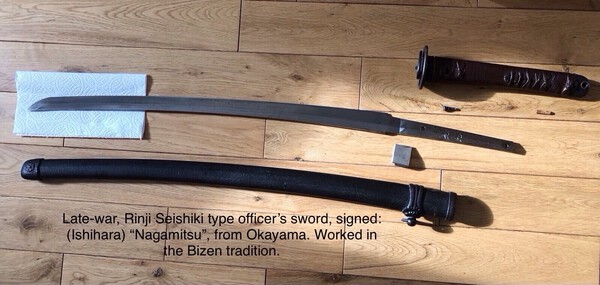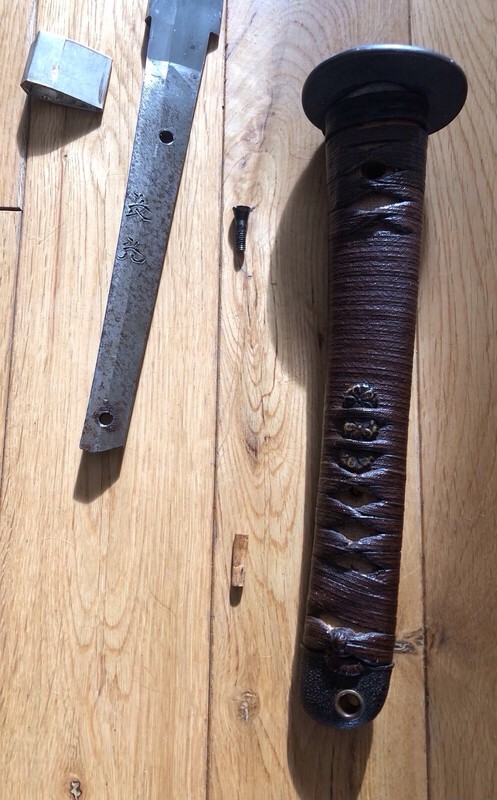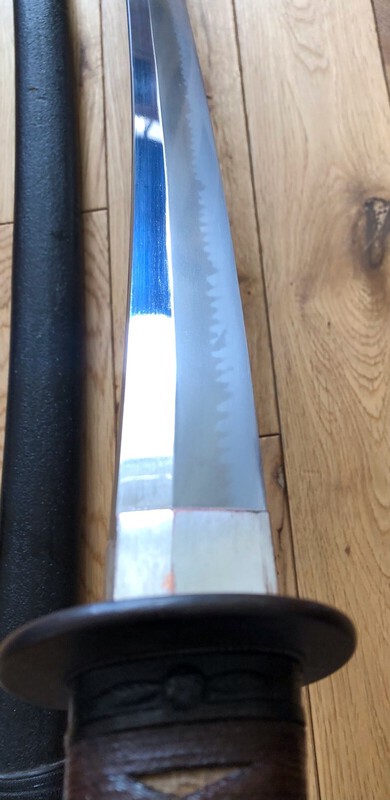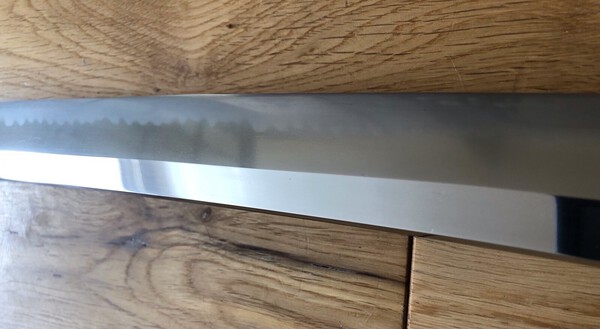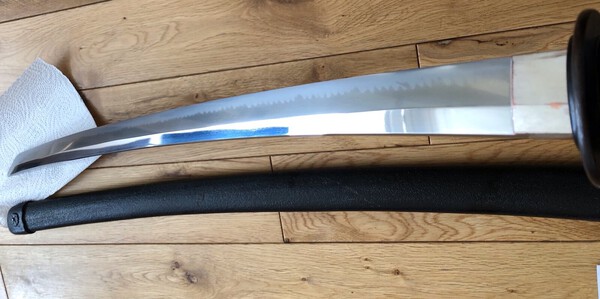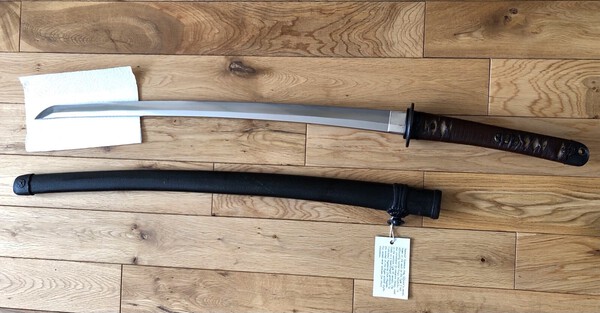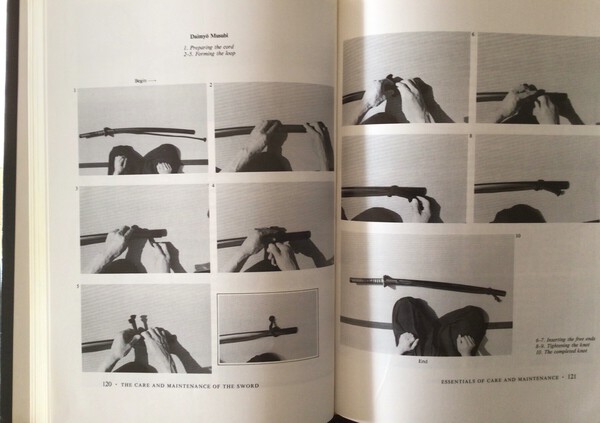
Beater
Members-
Posts
79 -
Joined
-
Last visited
-
Days Won
1
Content Type
Profiles
Forums
Events
Store
Downloads
Gallery
Everything posted by Beater
-
Thank you for your comments Charlie. A subject of which I have no knowledge whatsoever as my collecting has been mainly concentrated on gendaito swords from WW2. Having posted this for comments I have been reading some old threads about gold menuki on this forum and have quickly realised that cast and modern is not so desirable and I can appreciate the reasons. I am reluctant to name the gentleman who I initially asked for his thoughts as his main interest are tsubas and he freely admitted that in so far as menuki were concerned, there were gaps in his knowledge. He has written books on oriental art and I was informed was a curator in a museum with oriental artefacts, so he is someone who I respect. I will attach his email, name redacted, so others can read his thoughts. Whatever conclusions the more informed reach, nothing will take away from my joy at finding something like this on what was a dirty but very affordable tanto. I’m not trying to sell them or deceive anyone. Just after observations / comments.
-
-
I am more of a lurker than contributor to the forum but wanted to share a recent discovery and invite comments from those members who are interested in these menuki. First the background - I acquired a tanto in rather poor condition. A stout, mumei blade with some age in fairly sound condition. The koshirae were filthy, in particular the tsuka which appeared to have been in the home of a heavy smoker as entirely coated in a dark coating - possibly varnish to which grime had attached. The kashira was absent and ito broken but still mainly in place. Menuki indistinguishable, some sort of flower? There were clues that it had once been a presentable piece…two-piece habaki in shakudo and silver, nice iron fuchi with soft metal embellishments of a scroll and branch and an iron tsuba with wave pattern which had a separate shakudo rim. I sent the tsuka off for work - a replacement horn kashira and ito re-wrap. I subsequently heard from the restorer who asked me if I knew the menuki were solid gold? I did not. That was a nice surprise. I requested he take photos whilst they were off the tsuka, which he kindly did. (See attached.) Speaking of my good fortune to a couple of friends, they both advised putting the menuki in a presentation box and replacing with more modest ones. I spent too long thinking and by the time I contacted the restorer for an update, they were already back under the fresh ito! Didn’t really think too much more about it until contacting a friend who is very helpful regarding tsubas. I didn’t know if his knowledge extended to menuki. Anyway, his enthusiasm for them made me realise I should go for a wider exposure and see what this forum thinks. I welcome any information on possible school, age etc. They are of a cherry blossom and un-opened bud each on a Tanzaku (Poem paper), which I’m told is very much in Japanese taste. He notes the very unusual distinction of not having hollowed-out backs nor studs, both features he believes supports them being early. Many thanks in anticipation. Kevin.
-
Hi Conway, Thanks for clarification. I don’t think mine are brass, the base metal certainly does appear more like copper. K.
-
Oh, ok. Do you think that’s a bit of post-war tarting-up Bruce? I certainly haven’t painted anything.
-
They aren’t painted. k
-
I recently acquired this sword which has a number of features I found interesting. I was first drawn to it by the lightweight, lacquered wooden saya, which I understand to be a custom order feature. That and the silver mon caught my eye. The blade was also unusual. Deep sori, slender and graceful with odd length bo-hi which were longer than typical koshi-hi but not full length. I hadn’t owned one like that before. The nakago is short and the lower mekugi-ana seemed to be in an odd position - unless the tang had been shortened? The absence of a mei strengthened that belief although the nakago jiri was nicely shaped and not simply cut off square, as often seen. I suspect this was originally a longer sword, shortened to be an uchigatana in the late Koto period, when such swords became popular as single-handed slashers to accompany the longer tachi. Still a bit of a mystery which was now, I had decided, coming home with me. My next discovery was that the mon, which contained three kanji, not immediately recognised by me, were in fact a name. Not only that but the full name, presumably of the Japanese officer who owned it “HAYASHI MASATOMI”. Then on closer examination I saw that close to the habaki, on the mune, there was what was clearly a kiri-komi. Nice, a sword with history. Pure speculation but the early-war fittings, to be in such good condition with hardly a chip in the saya lacquer, hinted to me that this belonged to maybe a (senior?) officer away from the rain and mud of frontline campaign conditions? Who knows. Also a short (24”), lighter, slender blade wouldn’t be the obvious choice for someone who knew they may have to wield the sword in battle. Someone more knowledgeable than me (that’s pretty much everyone) suggested a possible Yamato influence but happy for anyone with ideas to chip in. Regards, Kevin.
-
One which may interest you - a research sword.
Beater replied to Beater's topic in Military Swords of Japan
-
I thought this sword may be of interest to you guys. A friend and Kendo / Iai practitioner, sent me some photos of a blade in shirasaya, which he is considering having mounted for iaido. He was unable to translate the saya-gaki, being relatively new to sword collecting and asked me for help. He said the tang was unsigned but did have some small and feint kanji. I got on with the immediate task of deciphering the saya-gaki but requested further photos of these feint tang kanji. So the saya clearly showed an early (4th year) Showa date - 1929 and the nagasa of the blade, which equated to approx 28”, which he confirmed matched the blades length. I figured the remaining brush strokes would likely be the maker’s and appraiser’s names? Unfortunately my friend’s request arrived whilst I am away from home and without books, I knew I’d struggle with the rest, so called upon Guy Powers in USA. All credit for the full translation and following info belongs entirely to Guy. So it seems this sword is an example of a “metal research sword” by Masahide. Unknown (certainly not recorded in Sesko) as a swordsmith, there is nevertheless information and other examples of his work, which praises his knowledge in the area of metallurgical research. His father, however, was a recognised swordsmith. So it is possible he had assistance / guidance in producing swords made with his own “ingredients”? Here’s the saya-gaki and photos of the nakago showing the feint kanji. What follows is the full translation from Guy and info of another sword by this smith together with background information, which I found fascinating. 金研正 Metals/Reseach Masa[hide] 正秀 Masahide 二尺三寸五分有元 森重 2-shaku 3-sun 5-bu [71.21 cm; 28.035 in.] 昭和四年春吉日 Showa 4th year [1929] an auspicious day in Spring 森重定 Mori Shigesada. This is the evaluator. I'm not 100% confident with定 it might be 道; also his surname might be 森重 Morishige. 金研正秀 Kinkyu Masahide's signature looks like this: Again a very feint, almost scratched mei. I found some references listing his blades as 金研刀 I think the "Kinkyu-to" nomenclature comes from 金 = 金属材料 Metals Material 研 = 研究 Research 刀 = Sword The source of the following info is: https://winners-auct.../productDetail/11207 青山橘(永十郎)正秀は、明治中期の著名刀匠青山永造青龍齊橘光秀の子息で、早くも20代の青年期に日本玉鋼の鍛錬極意を許された刀匠だった。 ※低温脆性は「将校用軍刀の研究」古来日本刀の弱点参照当時、金属材料では東北帝国大学金属材料研究所が頂点に君臨していた。永十郎正秀は従来の日本刀の鍛錬に飽き足らず、科学的日本刀鍛錬の大家として世界的に名声の高い「本多鋼」の創製者で東北帝大総長・本多光太郎博士の研究に惹かれた。その為、仙台市工業学校に入学。日本鋼の実地と学理を研鑽し、大正12年、東北帝大金属材料研究所に入所した。正秀の卓越した技量は本多博士に認められ、刃物研究部指導員に嘱託された。此処で鉄鋼学の一層の研鑽を積んだ。 Aoyama Tachibana (Eijuro) Masahide was the son of Aoyama Eizō Seiryūsai Tachibana Mitsuhide [see below from Sesko], a famous swordsmith in the middle of the Meiji era, and was a swordsmith who was allowed to master the secrets of forging Japanese jade steel [tamahagane] as early as his 20s. Research on officer's military swords” Reference to weaknesses of ancient Japanese swords. At that time, Tohoku Imperial University's Institute for Metals Materials reigned supreme in the field of metal materials. Eijuro Masahide was not satisfied with traditional Japanese sword training, He was drawn to the research of Dr. Kotaro Honda, the president of Tohoku Imperial University and the creator of ``Honda Steel,'' a world-famous master of scientific Japanese sword forging. Therefore, he entered Sendai City Technical School. He studied the practical and academic aspects of Japanese steel and joined the Tohoku Imperial University Institute of Metals and Materials in 1923. Masahide's outstanding skills were recognized by Dr. Honda, and he was appointed as an instructor in the cutlery research department. Here he further honed his skills in steel science. Mention of his father tempted me to check Markus Sesko's Japanese Swordsmiths: MITSUHIDE (光秀), Meiji (明治, 1868-1912), Miyagi – “Mitsuhide” (光秀), “Aoyama Seiryūsai Tachibana Mitsuhide” (青山青龍斎橘光秀), real name Aoyama Eizō (青山永造), gō Seiryūsai (青龍斎) I have obtained the sword owner’s permission to post here and full credit must be given to Guy.
-
My kaigunto, with silver mon on menuki. Good quality fittings with same-nuri saya. Blade by Ishido Mitsunobu (aka Teruhide) + Koa. Although I no longer own it, I previously had a kaigunto with silver mon on kabuto (crossed hawk feather design). That was a Shinto blade signed: “ Hoki no kami Fujiwara Nobutaka” and it had a surrender label which gave owners name as Surgeon Lieutenant Yasuo Ono. The label was included in Richard Fuller’s book on surrender tags / labels, page 95. I mention that because in that book approx 70 pages show army surrender labels whilst only about a dozen pages show navy. So, this question of why more silver mons on Shingunto than kaigunto can equally be applied to surrender labels. I suspect it has little to do with status or wealth and everything to do with personal choice and numerical statistics of those swords which survived. Heavy losses of their main capital ships, on which one assumes many senior officers perished along with their swords is a known fact. For a demonstration of that, take the largest number of Japanese officers known to surrender in one place, ie Jan 1946 Bangkok, Siam to Maj. Gen. Evans…that consisted of eighteen army Generals and just two navy admirals. So my guess is, we see fewer mon on kaigunto when compared with Shingunto simply because there are fewer to see. Kevin.
-
Hi Thomas, No stamps / numbers of any kind, including on the nakago mune . There is, however, a tiny Saka stamp on the neck of the saya’s haikan. I was unsure what the stamp was until I saw a recent photo in a thread by Deborah Nakamoto, showing the same stamp in same location on her ( Nagamitsu) sword, which sent me back for a second look at my own. Only then did I see it and made Bruce Pennington aware. Regards, Kevin.
-
Thanks Klaus, yes, seen that article. What I’d really like to find, if anyone has it, is a photograph of this smith. I’ve never come across one to date.
-
No date shown in your photos. Is there anything on the reverse side of tang? If not, then it is undated.
-
Hi there, Back in August 2023 I posted my Nagamitsu with rare long mei and dated. Thought I’d show this, my latest find, which complements the earlier one but has an abbreviated mei and is in Rinji Seishiki mounts. Hope you enjoy. Regards, Kevin.
-
Ishido Teruhide. http://www.japaneses...dex.com/teruhide.htm
-
Hi Henry, I think Grevedk has it covered. I thought I’d show you the (only) two methods I know and use and which are also the only two given in the book ”Japanese Swordsmanship” by Warner & Draeger. There may well be others and the various schools of swordsmanship all have their own versions of just about every aspect of sword use / etiquette, which defines their own interpretation - but these will serve you well for most situations. Regards, Kevin.
-
Just a thought, but would this be because of the death of Fujiwara Kanenaga, who worked at the Tenshozan forge and certainly signed many blades with his distinct small, precise kanji? I can’t recall the exact date of his death but I know it was in 1943. Regards, Kevin.
-
Any Nagamitsu fans out there - one for your perusal.
Beater replied to Beater's topic in Military Swords of Japan
Thanks Stephen;-) -
Any Nagamitsu fans out there - one for your perusal.
Beater replied to Beater's topic in Military Swords of Japan
-
Any stamps above or below the mei Pippo? 23rd generation Kanefusa used some interesting forging techniques, including the kabuse method. I used to own one that had a large stamp with lots of small kanji inside, situated below the mei, it effectively said made by the kabuse method. I believe it was a similar method to how Mantetsu swords were made ie by inserting a soft metal core inside a harder skin pipe? Agree, that is a nice hamon. https://www.Japanese...dex.com/kanefusa.htm
-
Any Nagamitsu fans out there - one for your perusal.
Beater replied to Beater's topic in Military Swords of Japan
Thanks for sharing Eric. What I see with yours and others I’ve seen for sale on Aoi etc is that post war art polishes reveal so much more than typical wartime polishes on Nagamitsu blades. He may have made decent swords but who ever polished for him set the bar low - I guess for wartime / campaign use all you really needed was a reasonable polish and sharpen. Your hada is very nice indeed. -
Any Nagamitsu fans out there - one for your perusal.
Beater replied to Beater's topic in Military Swords of Japan
Thank you. No, not suguha but there are lengths of hamon much less pronounced than the peaks of gunome you see clearly in my first batch of photos. Photo 4 shows the more pronounced gunome and photo 5, towards the kissaki, a more gentle. gunome. -
Any Nagamitsu fans out there - one for your perusal.
Beater replied to Beater's topic in Military Swords of Japan
Another interesting addition. So, that’s three katana-mei all in civilian mounts. I agree the koshirae does not look new. I did note the painted numbers on the nakago which I associate with aiding assembly - matching up blades to (military?) mounts, where the numbers are often repeated on the seppa etc. Can’t recall seeing painted assembly numbers on a Showa civilian-mounted sword…anyone? Quite a short katana at just over 24” (62.1cms). I understand that shorter and very stout blades are a feature of Nagamitsu. -
Any Nagamitsu fans out there - one for your perusal.
Beater replied to Beater's topic in Military Swords of Japan
So Trystan’s old thread revival of the “Crow Castle” sword which originally was in Type 98 fittings is signed tachi-mei, as is mine. Peter’s own bo-hi and the civilian mounted sword he has seen on eBay are both signed katana-mei. Not a large enough sample to draw any conclusions (yet) but it is shaping-up. I am coming round to the belief that Nagamitsu did not just randomly decide to sign tachi-mei or katana-mei, but did so based on the customers intended choice of mounts. -
Any Nagamitsu fans out there - one for your perusal.
Beater replied to Beater's topic in Military Swords of Japan
That would also be my hypothesis now I know it is civilian-mounted. One wonders if it were carried to war, with a leather combat cover? It is hard to imagine, with the great demand for officer’s swords at that time, that a martial arts practitioner could order a blade for their entirely personal, not military use, unless perhaps some respected Sensei, too old for military service but with sufficient status and clout to still get his wishes granted.










